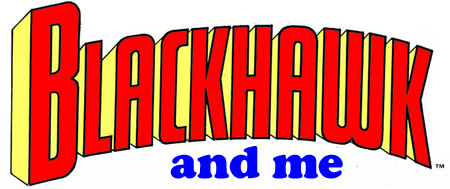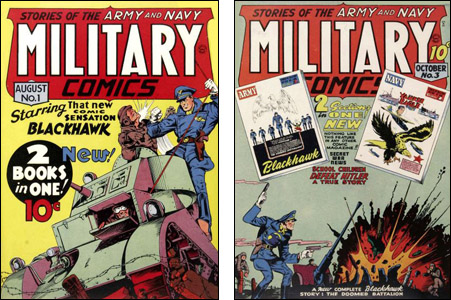Because I ask for them, I get a lot of questions sent to me at askme@newsfromme.com. I get asked about a lot of things but I'm probably asked the most about the Blackhawk comic book that I wrote (and sometimes edited) for DC Comics for what, when you think about it, was a teensy fraction of the history of that property. I probably have fifty e-mails in a folder on my D drive asking me how I got the job, why I left the job, how I felt about it, how it was to work with Dan Spiegle, etc.
The Spiegle question is the easiest answer. Dan was the main artist on the book while I was involved with it and he was a joy. Everything he drew was right and beautiful. Everything he drew was on-time. Matter of fact, much of it was handed in early. As you'll see in some part of this series down the line, one of my biggest problems on this assignment was keeping Dan busy.
The other questions are a little tougher and will require more bytes to explain so I've decided to tackle this as a series of articles that will run I-don't-know-how-many chapters. And I've decided to call it…

Now then: Blackhawk first appeared in Military Comics #1 cover-dated August of 1941. The feature was created by some combination of Will Eisner, Chuck Cuidera and Bob Powell. Cuidera and Powell were artists who were both then working in Eisner's "shop" where he and his staff created comic book material for various buyers.
I never met Bob Powell who died in 1967 but I got to spend some quality time with Will Eisner and a few hours at one convention with Chuck Cuidera. Depending on how you phrased the question and what mood they were in, either Will or Chuck might tell you that any one, two or three of that trio created Blackhawk. Gil Kane once told me that if I'd been able to ask Powell, he'd have told me he created it and would threaten to beat the crap out of anyone who said otherwise.

And to further muddy the waters, that first issue of Military Comics also featured the debut of The Death Patrol, a feature by Jack Cole (best known as the creator of Plastic Man) that had many similarities to Blackhawk, and which Eisner said was written and drawn before the first Blackhawk story. And as if those waters weren't muddy enough, let's thrown in another bit of confusion which is tangentially related…
Chuck Cuidera's full name was Charles Nicholas Cuidera and at times, he claimed that he was the "Charles Nicholas" who created an earlier property for another company, an anemic super-hero called The Blue Beetle. And Cuidera was among the many people who did draw The Blue Beetle but most historian-types think the "Charles Nicholas" whose name appeared on that strip was another of those artists, Charles Nicholas Wojtkoski. And Will Eisner, I've heard, sometimes claimed he wrote the first Blue Beetle story.
So I don't want to say who created Blackhawk — or The Blue Beetle, for that matter — and I regret the few times in the past when I tried to sort it out. What we can say is that Blackhawk (published by a firm called Quality Comics) and Blue Beetle (which started at a company called Fox Features) both had long, long lives…and both wound up being published and owned by DC Comics.
Blackhawk was a hit in Military Comics and soon there was a regular, top-selling Blackhawk comic book. Many different writers and artists worked on the strip over the years but the outstanding artist was probably Reed Crandall, who came and went from the strip between 1942 and 1953. The most prolific penciler was Dick Dillin. The most prolific inker of both was Chuck Cuidera. Dillin and Cuidera were the artists in 1956, which was when Quality Comics sold Blackhawk and a few other properties to DC Comics. And Dillin and Cuidera did almost all the art from the moment DC took it over until 1968.
In 1968, Carmine Infantino was increasingly running things at DC and he was charged with weeding out the comics that weren't selling or making them sell. Blackhawk, for reasons we'll get into in the next part, wasn't selling. And this feels like a good spot to end this first part.